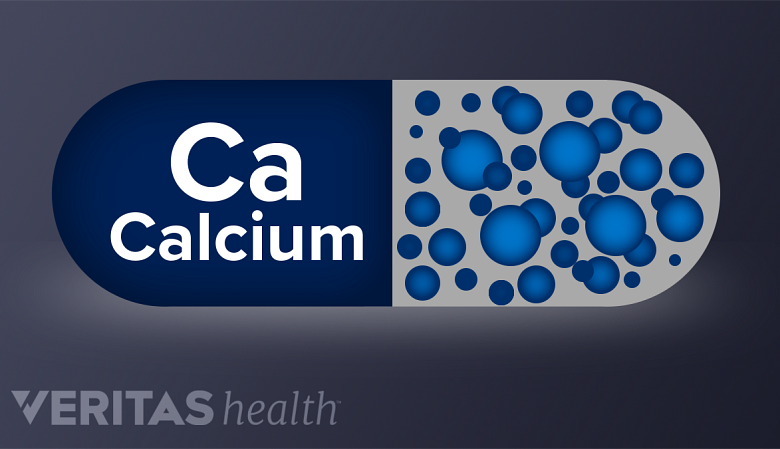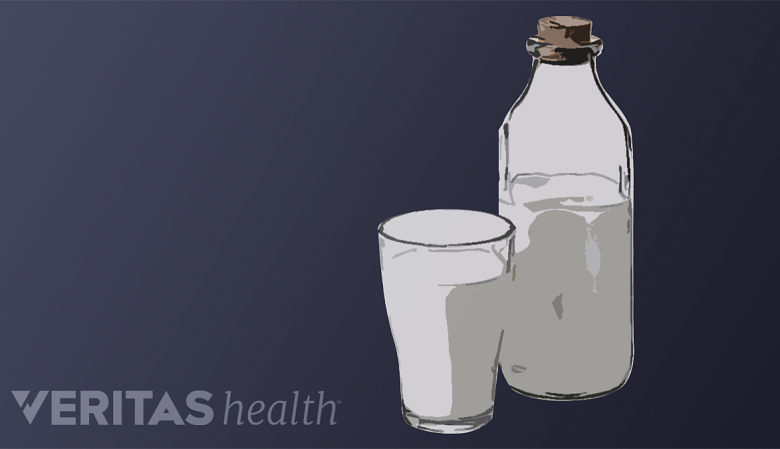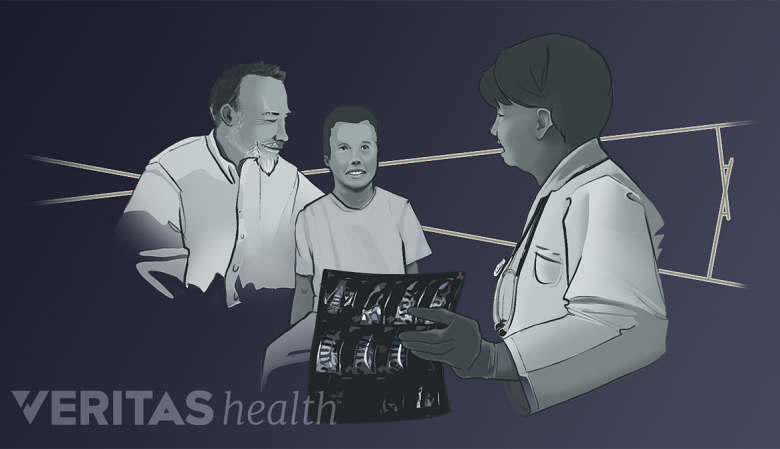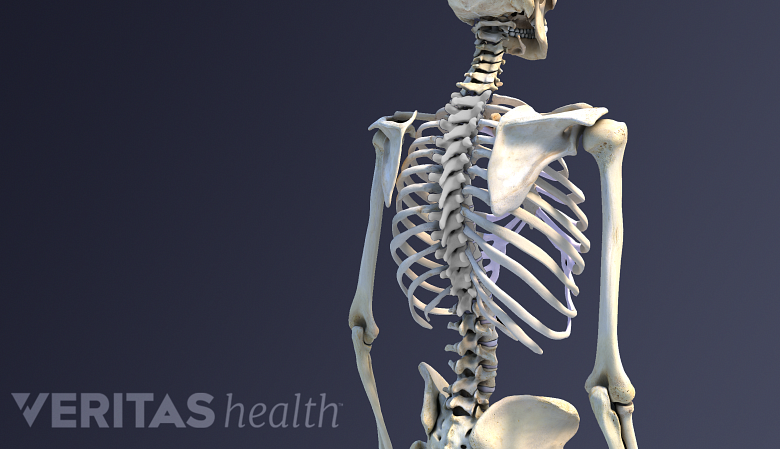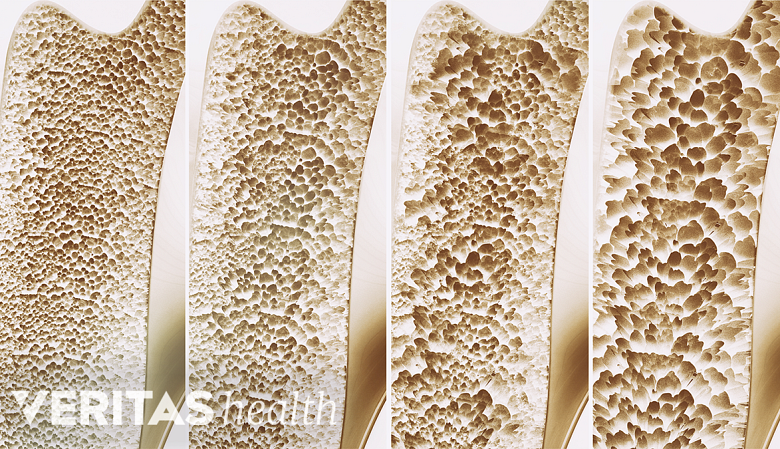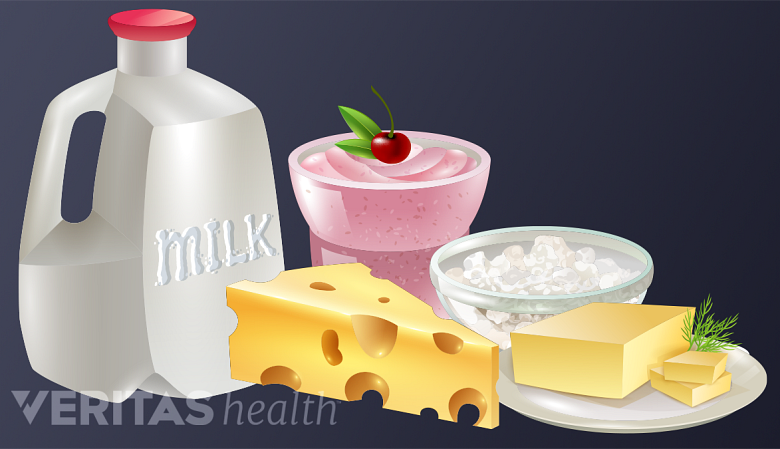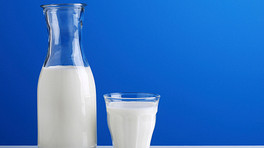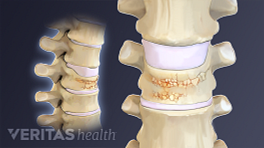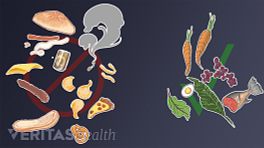Calcium that is absorbed and deposited into kids’ growing bones during childhood influences the final bone mass, density, and strength during adulthood. The bones store 98% of the body’s calcium, most of which is accrued during childhood and early adolescence.
Calcium helps kids’ bones grow and provides them with strength, rigidity, and structure. Calcium is also found in the blood and plays a vital role in the proper functioning of the circulatory, muscular, nervous, and hormonal systems in the body. 1 Zhu K, Prince RL. Calcium and bone. Clinical Biochemistry. 2012;45(12):936-942. doi:10.1016/j.clinbiochem.2012.05.006 , 2 Shlisky J, Mandlik R, Askari S, et al. Calcium deficiency worldwide: prevalence of inadequate intakes and associated health outcomes. Annals NY Academy of Science. 2022;1512(1):10-28. doi:10.1111/nyas.14758 , 3 Institute of Medicine (US) Committee to Review Dietary Reference Intakes for Vitamin D and Calcium; Ross AC, Taylor CL, Yaktine AL, et al., editors. Dietary Reference Intakes for Calcium and Vitamin D. Washington (DC): National Academies Press (US); 2011. 2, Overview of Calcium. Available from: https://www.ncbi.nlm.nih.gov/books/NBK56060/
In This Article:
- Calcium Requirements for Kids' Growing Bones
- Calcium-Rich Foods for Kids: A Complete Guide
- How to Increase Bone Density
Calcium Requirements for Kids: What Parents Need to Know
Calcium is an important mineral that needs to be consumed through food.
The need for increased calcium acquisition and storage begins in childhood and continues through the pre-adolescent years.
To maintain strong bones, the overall goals are to:
- Consume the recommended amount of calcium-rich food
- Allow maximal absorption of calcium from the intestines by eating vitamin-D-rich foods or getting adequate sunlight exposure
- Store as much calcium in the bone as one can, especially during the pre-pubertal and pubertal years
- Prevent losses of calcium and other minerals from the bone over the years through healthy lifestyle and dietary habits
To attain these goals, calcium and vitamin D consumption must be prioritized through childhood to meet the daily-recommended dose requirements.
How Much Calcium do Kids Need: A Guide for Parents
The recommended calcium intake depends on the age of the child or adult.
A high calcium intake is required during the growing years to build optimum bone mass. The recommended dietary allowance for calcium for kids and teens in the United States is described in the table below. There’s no difference in the recommended intake for boys and girls.
Dietary calcium: recommended intakes for 1–18-year-olds 4 Office of dietary supplements - calcium. Accessed October 28, 2022. https://ods.od.nih.gov/factsheets/Calcium-HealthProfessional/
| Age Group (years) | Recommended Dietary Allowances (RDAs) for Calcium (mg / day) |
|---|---|
| 1-3 | 700 |
| 4-8 | 1000 |
| 9-18 | 1300 |
To achieve these values, the approximate number of food servings per day include:
- 2-3 servings of calcium-rich foods for toddlers and school-age kids 1-8 years old
- 3-4 servings of calcium-rich foods for tweens and teens 9-18 years old
To put these values in perspective, a glass of milk, a serving of yogurt, and a serving of cheese—each contains around 300 g of calcium—providing the day’s calcium intake for a toddler or school-age kid if all three foods are eaten. Other food groups such as cruciferous veggies (eg, kale and broccoli) also provide adequate amounts of calcium. 5 Rozenberg S, Body JJ, Bruyère O, et al. Effects of Dairy Products Consumption on Health: Benefits and Beliefs--A Commentary from the Belgian Bone Club and the European Society for Clinical and Economic Aspects of Osteoporosis, Osteoarthritis and Musculoskeletal Diseases. Calcif Tissue Int. 2016;98(1):1-17. doi:10.1007/s00223-015-0062-x
Dietary calcium: recommended intake for infants
For infants aged 0 to 6 months, 200 mg of calcium is needed per day, and for those 7 to 12 months, the average intake should be around 260 mg per day. These values are established based on the mean intake of calcium in healthy, breastfed infants. 4 Office of dietary supplements - calcium. Accessed October 28, 2022. https://ods.od.nih.gov/factsheets/Calcium-HealthProfessional/ Calcium intake for formula-fed fed infants comes from the infant formula, which is fortified with calcium. Breastfed infants get their daily calcium through breast milk.
Any concerns or questions regarding the amount of calcium intake in children or teens must be discussed with a pediatrician.
9 to 14 Years: The Age Group of Peak Bone Growth
Adequate calcium intake during childhood helps store enough calcium in the bones.
Bone growth is at its peak around puberty, in kids 9 to 14 years of age, when the bones increase in size and the bone mass approximately doubles. The bulk of calcium that is absorbed by the bones during this period plays a key role in influencing the final bone mass in adulthood. In addition to calcium, it is also important to include a balanced diet that contains adequate amounts of phosphorus, magnesium, and vitamin D to help enhance calcium absorption and promote overall bone growth and development. 1 Zhu K, Prince RL. Calcium and bone. Clinical Biochemistry. 2012;45(12):936-942. doi:10.1016/j.clinbiochem.2012.05.006 , 6 Abrams SA. Bone Health in School Age Children: Effects of Nutritional Intake on Outcomes. Front Nutr. 2021;8:773425. Published 2021 Nov 19. doi:10.3389/fnut.2021.773425 , 7 Baxter-Jones AD, Faulkner RA, Forwood MR, Mirwald RL, Bailey DA. Bone mineral accrual from 8 to 30 years of age: An estimation of peak bone mass. J Bone Miner Res. 2011;26(8):1729-1739. doi:10.1002/jbmr.412 , 8 Markou KB, Theodoropoulou A, Tsekouras A, Vagenakis AG, Georgopoulos NA. Bone acquisition during adolescence in athletes. Ann N Y Acad Sci. 2010 Sep;1205:12-6. doi: 10.1111/j.1749-6632.2010.05675.x. PMID: 20840247.
See Calcium Is Needed for Strong Bones
In addition to nutrition, other factors such as genetics, gender, and hormones also influence the final bone mass in individuals. 1 Zhu K, Prince RL. Calcium and bone. Clinical Biochemistry. 2012;45(12):936-942. doi:10.1016/j.clinbiochem.2012.05.006 After the child’s growth period is complete, the calcium content of the bone continues to increase for several years, so calcium consumption remains important throughout adolescence and even into young adulthood. 7 Baxter-Jones AD, Faulkner RA, Forwood MR, Mirwald RL, Bailey DA. Bone mineral accrual from 8 to 30 years of age: An estimation of peak bone mass. J Bone Miner Res. 2011;26(8):1729-1739. doi:10.1002/jbmr.412
2 Reasons Why Calcium Is Essential for Kids’ Growth and Development
Calcium helps strengthen the structure of the skeleton.
Calcium is the principal mineral contained in bone—and gives it the structure and strength needed to support the body through life. Calcium is also important for the optimal functioning of the body’s cells and tissues.
1. Calcium builds bones
In the bones, calcium serves the following functions 3 Institute of Medicine (US) Committee to Review Dietary Reference Intakes for Vitamin D and Calcium; Ross AC, Taylor CL, Yaktine AL, et al., editors. Dietary Reference Intakes for Calcium and Vitamin D. Washington (DC): National Academies Press (US); 2011. 2, Overview of Calcium. Available from: https://www.ncbi.nlm.nih.gov/books/NBK56060/ :
- Calcium deposits help the body’s skeleton to develop through a physiologic process called bone remodeling. Bone remodeling involves several processes that ultimately result in an increase in bone size and modification of its shape.
- Calcium helps strengthen the structure of the skeleton and establish rigidity and elasticity in bony tissues.
Engaging in physical activities and participating in weight-bearing exercise prompt bone formation and improve bone calcium accrual in children and adolescents. 9 Golden NH, Abrams SA, COMMITTEE ON NUTRITION, et al. Optimizing bone health in children and adolescents. Pediatrics. 2014;134(4):e1229-e1243. doi:10.1542/peds.2014-2173
2. Calcium is vital for the healthy functioning of the body’s cells
A small fraction of the body’s calcium is present in the blood and acts as a messenger that travels between cells in the body to mediate proper functioning, such as 3 Institute of Medicine (US) Committee to Review Dietary Reference Intakes for Vitamin D and Calcium; Ross AC, Taylor CL, Yaktine AL, et al., editors. Dietary Reference Intakes for Calcium and Vitamin D. Washington (DC): National Academies Press (US); 2011. 2, Overview of Calcium. Available from: https://www.ncbi.nlm.nih.gov/books/NBK56060/ :
- Blood vessel constriction and dilation
- Blood clotting
- Muscle function
- Nerve transmission
- Hormone secretion
A lifelong supply of calcium to fulfill these critical metabolic needs comes from the bones—making it essential to consume and store this crucial mineral during the peak bone growth period in childhood.
The Calcium-Vitamin D Connection
A deficiency of vitamin D can result in poor absorption of calcium and low bone quality.
Vitamin D plays an important role in the absorption of calcium from food and regulates the level of calcium in the blood.
- When the blood-calcium level is low and unable to adequately support the body’s metabolic functions, an increase in the production of vitamin D is triggered. 10 Holick MF. The Vitamin D Solution: A 3-Step Strategy to Cure Our Most Common Health Problem. Hudson Street Press; 2010.
- Vitamin D in turn prompts the intestines to absorb more calcium from food and transfer it to the blood. 10 Holick MF. The Vitamin D Solution: A 3-Step Strategy to Cure Our Most Common Health Problem. Hudson Street Press; 2010.
- If the dietary intake of calcium is low and the intestines are unable to absorb enough calcium, vitamin D and other hormones (such as the parathyroid hormone) trigger a process in which stored calcium is extracted from the bones. 10 Holick MF. The Vitamin D Solution: A 3-Step Strategy to Cure Our Most Common Health Problem. Hudson Street Press; 2010.
A deficiency of vitamin D can result in poor absorption of calcium from the intestines, even if calcium is consumed through the diet—eventually leading to excessive loss of calcium from the bones and decreased calcium deposition in the bone.
Recommended Vitamin D Intake for Kids And Teens
For optimal calcium regulation and to maintain adequate bone health, the American Academy of Pediatrics (AAP) recommends the following 9 Golden NH, Abrams SA, COMMITTEE ON NUTRITION, et al. Optimizing bone health in children and adolescents. Pediatrics. 2014;134(4):e1229-e1243. doi:10.1542/peds.2014-2173 :
| Age of the child | Recommended Intake of Vitamin D per Day |
|---|---|
| Infants (below 1 year of age) | 400 IU |
| Toddlers, older kids, and teens | 600 IU |
Vitamin D can be obtained through sunlight exposure (UV B radiation) and dietary sources, such as cod liver oil, fatty fish (eg, salmon, sardines, tuna), and fortified foods (infant formula, dairy, fruit juices, etc). 9 Golden NH, Abrams SA, COMMITTEE ON NUTRITION, et al. Optimizing bone health in children and adolescents. Pediatrics. 2014;134(4):e1229-e1243. doi:10.1542/peds.2014-2173
2 Ways to Increase Calcium Absorption and Retention
Understanding the dietary interactions between foods can help increase the absorption, retention, and storage of calcium. It is important to note that not all calcium consumed through the diet is absorbed by the body.
1. Eat more calcium-rich food
Dairy is a rich source of calcium.
Calcium is absorbed in the gut. The type and combination of foods consumed may improve or inhibit the amount of calcium the body absorbs.
- About 30% of calcium is absorbed from dairy and fortified foods, such as milk, cheese, yogurt, orange juice, tofu, and soy milk. 3 Institute of Medicine (US) Committee to Review Dietary Reference Intakes for Vitamin D and Calcium; Ross AC, Taylor CL, Yaktine AL, et al., editors. Dietary Reference Intakes for Calcium and Vitamin D. Washington (DC): National Academies Press (US); 2011. 2, Overview of Calcium. Available from: https://www.ncbi.nlm.nih.gov/books/NBK56060/
- About 40% of calcium is absorbed from certain green vegetables, including but not limited to bok choy, broccoli, and kale. 3 Institute of Medicine (US) Committee to Review Dietary Reference Intakes for Vitamin D and Calcium; Ross AC, Taylor CL, Yaktine AL, et al., editors. Dietary Reference Intakes for Calcium and Vitamin D. Washington (DC): National Academies Press (US); 2011. 2, Overview of Calcium. Available from: https://www.ncbi.nlm.nih.gov/books/NBK56060/ , 11 Burckhardt P. Calcium revisited, part III: effect of dietary calcium on BMD and fracture risk. Bonekey Rep. 2015;4:708. Published 2015 Aug 5. Available from https://www.ncbi.nlm.nih.gov/pmc/articles/PMC4549924/
The amount of absorbed calcium may become less if foods that bind calcium or interfere with its absorption are consumed at the same time. 3 Institute of Medicine (US) Committee to Review Dietary Reference Intakes for Vitamin D and Calcium; Ross AC, Taylor CL, Yaktine AL, et al., editors. Dietary Reference Intakes for Calcium and Vitamin D. Washington (DC): National Academies Press (US); 2011. 2, Overview of Calcium. Available from: https://www.ncbi.nlm.nih.gov/books/NBK56060/
2. Restrict the consumption of oxalic acid- and phytic acid-containing foods along with calcium-rich food
Spinach contains oxalic acid that may reduce the absorption of calcium when taken together.
Oxalic acid and phytic acid are compounds present in certain foods, which have the ability to bind to calcium and reduce its absorption. Oxalic acid-containing foods include spinach, collard greens, sweet potatoes, rhubarb, and beans. Phytic acid is contained in whole grains, beans, seeds, nuts, and soy. 3 Institute of Medicine (US) Committee to Review Dietary Reference Intakes for Vitamin D and Calcium; Ross AC, Taylor CL, Yaktine AL, et al., editors. Dietary Reference Intakes for Calcium and Vitamin D. Washington (DC): National Academies Press (US); 2011. 2, Overview of Calcium. Available from: https://www.ncbi.nlm.nih.gov/books/NBK56060/ , 11 Burckhardt P. Calcium revisited, part III: effect of dietary calcium on BMD and fracture risk. Bonekey Rep. 2015;4:708. Published 2015 Aug 5. Available from https://www.ncbi.nlm.nih.gov/pmc/articles/PMC4549924/ , 12 Yang J, Punshon T, Guerinot ML, Hirschi KD. Plant calcium content: ready to remodel. Nutrients. 2012;4(8):1120-1136. doi:10.3390/nu4081120
Here are two examples of how overall calcium absorption is affected when certain food groups are consumed together:
- Eating spinach and drinking milk as a part of the same meal will reduce the absorption of calcium contained in both spinach and milk. 3 Institute of Medicine (US) Committee to Review Dietary Reference Intakes for Vitamin D and Calcium; Ross AC, Taylor CL, Yaktine AL, et al., editors. Dietary Reference Intakes for Calcium and Vitamin D. Washington (DC): National Academies Press (US); 2011. 2, Overview of Calcium. Available from: https://www.ncbi.nlm.nih.gov/books/NBK56060/ , 13 Brogren M, Savage GP. Bioavailability of soluble oxalate from spinach eaten with and without milk products. Asia Pac J Clin Nutr. 2003;12(2):219-24. PMID: 12810415. Available from: https://pubmed.ncbi.nlm.nih.gov/12810415/
- On the other hand, when kale or broccoli and milk are taken as a part of the same meal, a much higher amount of calcium is absorbed in the body from both foods. 3 Institute of Medicine (US) Committee to Review Dietary Reference Intakes for Vitamin D and Calcium; Ross AC, Taylor CL, Yaktine AL, et al., editors. Dietary Reference Intakes for Calcium and Vitamin D. Washington (DC): National Academies Press (US); 2011. 2, Overview of Calcium. Available from: https://www.ncbi.nlm.nih.gov/books/NBK56060/ , 11 Burckhardt P. Calcium revisited, part III: effect of dietary calcium on BMD and fracture risk. Bonekey Rep. 2015;4:708. Published 2015 Aug 5. Available from https://www.ncbi.nlm.nih.gov/pmc/articles/PMC4549924/
It’s important to note that foods that contain oxalic acid and phytic acid are rich in other nutrients, so it is essential to include them in the diet, but try to minimize their consumption together with calcium-rich foods.
Calcium is an important mineral that plays a fundamental role in establishing bone mass and bone strength in addition to mediating cellular functions throughout the body. Calcium deposition and buildup in the bones largely take place during childhood and adolescence.
See Lifestyle and Diet Tips for Healthy Bones
Children who consume a balanced diet that includes the recommended amounts of calcium can help preserve their bone density and strength through adulthood and prevent bone problems later in life.
- 1 Zhu K, Prince RL. Calcium and bone. Clinical Biochemistry. 2012;45(12):936-942. doi:10.1016/j.clinbiochem.2012.05.006
- 2 Shlisky J, Mandlik R, Askari S, et al. Calcium deficiency worldwide: prevalence of inadequate intakes and associated health outcomes. Annals NY Academy of Science. 2022;1512(1):10-28. doi:10.1111/nyas.14758
- 3 Institute of Medicine (US) Committee to Review Dietary Reference Intakes for Vitamin D and Calcium; Ross AC, Taylor CL, Yaktine AL, et al., editors. Dietary Reference Intakes for Calcium and Vitamin D. Washington (DC): National Academies Press (US); 2011. 2, Overview of Calcium. Available from: https://www.ncbi.nlm.nih.gov/books/NBK56060/
- 4 Office of dietary supplements - calcium. Accessed October 28, 2022. https://ods.od.nih.gov/factsheets/Calcium-HealthProfessional/
- 5 Rozenberg S, Body JJ, Bruyère O, et al. Effects of Dairy Products Consumption on Health: Benefits and Beliefs--A Commentary from the Belgian Bone Club and the European Society for Clinical and Economic Aspects of Osteoporosis, Osteoarthritis and Musculoskeletal Diseases. Calcif Tissue Int. 2016;98(1):1-17. doi:10.1007/s00223-015-0062-x
- 6 Abrams SA. Bone Health in School Age Children: Effects of Nutritional Intake on Outcomes. Front Nutr. 2021;8:773425. Published 2021 Nov 19. doi:10.3389/fnut.2021.773425
- 7 Baxter-Jones AD, Faulkner RA, Forwood MR, Mirwald RL, Bailey DA. Bone mineral accrual from 8 to 30 years of age: An estimation of peak bone mass. J Bone Miner Res. 2011;26(8):1729-1739. doi:10.1002/jbmr.412
- 8 Markou KB, Theodoropoulou A, Tsekouras A, Vagenakis AG, Georgopoulos NA. Bone acquisition during adolescence in athletes. Ann N Y Acad Sci. 2010 Sep;1205:12-6. doi: 10.1111/j.1749-6632.2010.05675.x. PMID: 20840247.
- 9 Golden NH, Abrams SA, COMMITTEE ON NUTRITION, et al. Optimizing bone health in children and adolescents. Pediatrics. 2014;134(4):e1229-e1243. doi:10.1542/peds.2014-2173
- 10 Holick MF. The Vitamin D Solution: A 3-Step Strategy to Cure Our Most Common Health Problem. Hudson Street Press; 2010.
- 11 Burckhardt P. Calcium revisited, part III: effect of dietary calcium on BMD and fracture risk. Bonekey Rep. 2015;4:708. Published 2015 Aug 5. Available from https://www.ncbi.nlm.nih.gov/pmc/articles/PMC4549924/
- 12 Yang J, Punshon T, Guerinot ML, Hirschi KD. Plant calcium content: ready to remodel. Nutrients. 2012;4(8):1120-1136. doi:10.3390/nu4081120
- 13 Brogren M, Savage GP. Bioavailability of soluble oxalate from spinach eaten with and without milk products. Asia Pac J Clin Nutr. 2003;12(2):219-24. PMID: 12810415. Available from: https://pubmed.ncbi.nlm.nih.gov/12810415/
